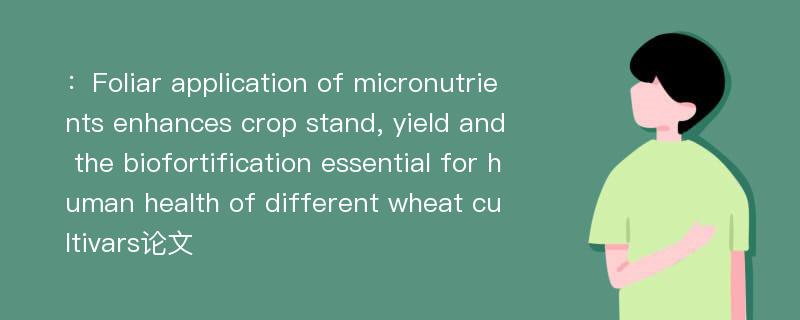
本文主要研究内容
作者(2019)在《Foliar application of micronutrients enhances crop stand, yield and the biofortification essential for human health of different wheat cultivars》一文中研究指出:Globally about half of the world’s population is under micronutrient malnutrition due to poor quality food intake. To overcome this problem, fortification and biofortification techniques are often used. Biofortification is considered a better option than fortification due to the easy control of nutrient deficiencies present in daily food. This field experiment was conducted to evaluate the effects of foliar application of a micronutrient mixture(MNM) consisting of zinc(Zn), iron(Fe), copper(Cu), manganese(Mn) and boron(B) on yield and flour quality of wheat. The results show the effectiveness of foliar feeding for growth and yield parameters, in addition to the enriching of wheat grains with Zn, Cu, Fe, Mn and B. Compared to the control without foliar feeding, foliar application on wheat crop increased tillering ability, spike length, grain yield and the contents of Zn, Cu, Mn, Fe and B by 21, 47, 22, 22 and 25% in wheat flour, respectively. Therefore, foliar feeding of micronutrients could be an effective approach to enrich wheat grains with essential nutrients for correcting malnutrition.
Abstract
Globally about half of the world’s population is under micronutrient malnutrition due to poor quality food intake. To overcome this problem, fortification and biofortification techniques are often used. Biofortification is considered a better option than fortification due to the easy control of nutrient deficiencies present in daily food. This field experiment was conducted to evaluate the effects of foliar application of a micronutrient mixture(MNM) consisting of zinc(Zn), iron(Fe), copper(Cu), manganese(Mn) and boron(B) on yield and flour quality of wheat. The results show the effectiveness of foliar feeding for growth and yield parameters, in addition to the enriching of wheat grains with Zn, Cu, Fe, Mn and B. Compared to the control without foliar feeding, foliar application on wheat crop increased tillering ability, spike length, grain yield and the contents of Zn, Cu, Mn, Fe and B by 21, 47, 22, 22 and 25% in wheat flour, respectively. Therefore, foliar feeding of micronutrients could be an effective approach to enrich wheat grains with essential nutrients for correcting malnutrition.
论文参考文献
论文详细介绍
论文作者分别是来自Journal of Integrative Agriculture的,发表于刊物Journal of Integrative Agriculture2019年06期论文,是一篇关于,Journal of Integrative Agriculture2019年06期论文的文章。本文可供学术参考使用,各位学者可以免费参考阅读下载,文章观点不代表本站观点,资料来自Journal of Integrative Agriculture2019年06期论文网站,若本站收录的文献无意侵犯了您的著作版权,请联系我们删除。
